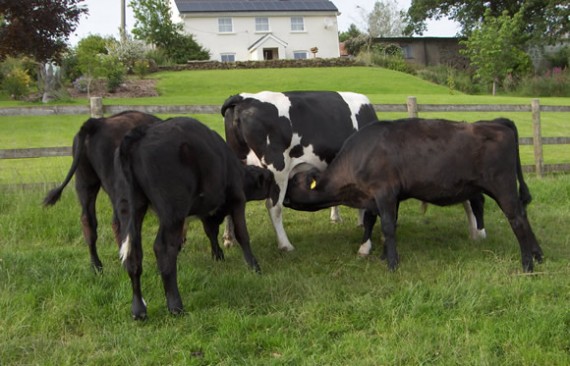Multiple-Suckling with Shetland Cattle
Ever since my first acquaintance with the Shetland cow I have been aware of the importance of its milkiness both in the life of the crofting family as well as a means of producing some additional income. Its role as a crofter's cow, its appearance and origins are well documented in the SCHBS and SCBA promotional material and the Centenary Celebration publication "A Pictorial Daander Trowe Shetland's Crofting Culture"…
The role of the Shetland cow in modern agriculture is well known to all: the ideal cow for the smallholder with the ability to flourish on poor and limited grazing and yet can hold her own remarkably well in larger herds; her small size and light frame is less likely to poach the limited pasture in wet weather; extremely efficient in converting grass to milk and hence to beef via her calf… acknowledgement of the excellent dual purpose nature of this breed; requires less supplementary feeding than other breeds.
Looking in to the milkiness of this breed and the milk trials undertaken by the Scottish Agricultural College in conjunction with the Shetland Cattle Herd book Society, there is a lot to be said for using this milkiness to further advantage. It was during the SCBA visit to Shetland in 2010 that the idea of multiple-suckling came to me. This was as a result of a visit to the Hillwell herd at Quendale where multiple-suckling has been part of the herd management for generations.
To see four cows in a park with sixteen calves, three cows in another park with ten calves and other groups of cows with more than one calf each was memorizing. Cows looked well, calves well grown and contented. Discussion as to how this had been achieved made me realise that here was a means of adding value to the Shetland cow and using the milkiness to produce a pure Shetland calf as well as an additional income without compromising the health and well-being of the cow.
I could, of course, take off the additional milk after calving and use it for the house, butter or cheese making but that was going to be more labour intensive when intensive labour was what was already involved with sixteen Farmers' Markets a month selling Shetland lamb and beef!
One of my older cows, St Trinians Cloudy, was due to calve December 2010 and hand milking was what I was going to do… but, 11.30pm. on Christmas eve, snowed into the farm, every pipe in the barn frozen, and two angus cross calves available on a neighbouring dairy farm I'm afraid that multiple-suckling seemed a slightly easier option!
We fetched the calves on Christmas morning using a tractor, sliding all over the half mile drive down to the road, struggling up the three quarter mile lane to the dairy farm and then going across fields to get any purchase on the ice to return to Welland Down Farm! We put the calves with Clemmy, Cloudy's calf, in a pen adjacent to her, but out of sight. Christmas evening we let the calves in to the main pen after we had haltered and given Cloudy a bowl of feed. A little bit of kicking and fidgeting and the calves latched on.
I was there to growl at Cloudy, but over the following days everything settled down to twice a day suckling. Hay, water and calf pellets were available to the calves and Cloudy had access to hay and silage as well as her hard feed. (Rolled barley, soaked sugar beet and some roots).
After a week or so the calves were allowed creep access to Cloudy and from then on they were outside and feeding times were very much controlled by Cloudy herself. The calves always went to the same quarter and only when Cloudy felt that her udder needed relieving!
 Multiple-suckling with Shetland cattle
Multiple-suckling with Shetland cattle
That was the start of multiple-suckling at Welland Down! Since then, any older cow as it has calved down has had additional Angus cross calves put to her, sometimes three, some times four. This depends what is available on our neighbouring dairy farm. Our neighbours always use an Angus bull on their first time heifer calvers to produce a smaller calf… ideal for suckling to a Shetland cow: the calves are all a much of a muchness with regard to size.
The growth rates are extraordinary and when it comes to weaning the Angus-cross calves, whether steers or heifers are ready to be sold as stirks. Sometimes we do run them on a bit longer depending on the stage in the season: a Spring sale will generally produce better returns than an Autumn sale, but winter feed does have to put into the equation in that case.
We only use older cows for multiple-suckling when they have had a chance to achieve higher milk yields. A first time calver, we feel, needs to have the opportunity to continue to build both body frame and udder capacity.
At the end of the day, I feel that each calving is producing a pure bred Shetland animal, my aim in all this, as well as an acceptable and welcome additional income. We are in the enviable position of having suckler calves readily available on neighbouring land, without having to go though the open market where infections and viruses would destroy the incentive for going down the multi-suckling route.
You can find out more about The Accidental Smallholder's herd of Shetland Cattle at the Rosedean Shetland Cattle website.
- Previous « Fencing for cattle
About Dodie Huxter
Dodie Huxter has farmed cattle, with her husband, since 1999 when they started a herd of Ruby Red Devons. Shetland cattle were introduced in 2008, as a result of Dodie’s love of “all things Shetland”.
Further Reading
 Caring for Cows Val Porter |  Practical Cattle Farming Kat Bazeley |  The Illustrated Guide to Cows Celia Lewis |  Cows for the Smallholder Val Porter |  |













